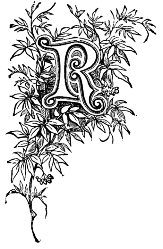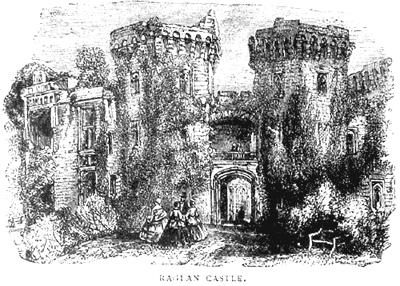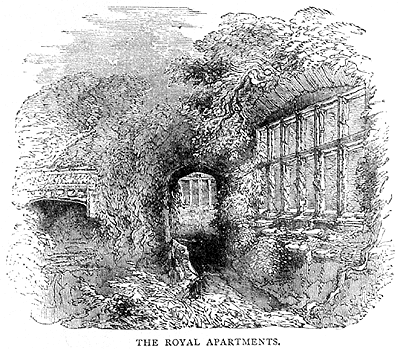 |

AGLAN CASTLE is situated at about eight miles from Monmouth, and be longs to the Duke of Beaufort, to whom it gives the title of Baron.
The ruins are very picturesque, and the castle, when in perfection, must have been a noble residence. There is some doubt as to when it was founded; but the best authority says, that it was built by Sir William Thomas and his son William, Earl of Pembroke.
Sir William Thomas was one of two brave squires - David Gam was the other who gave their lives to save that of their king at the battle of Agincourt; Henry knighting both, as they lay dying on the field. The Earl of Pembroke was beheaded at Banbury in 1469.
In a direct line with the building were three gates; the first of brick, from which the white gate, which was built of squared stones, was reached by the ascent of many steps.
At some little distance on the left hand stands the tower Melin-y-Gwent (the yellow tower of Gwent) which in height and strength surpassed almost every other tower in England. It was six-sided; the walls were ten feet thick of square stones; it was five stories high, and commanded a most beautiful view of the adjacent country, which is very picturesque. It was battlemented, but the battlements were only eight inches thick, and not equal to sustaining cannon shot. This tower was joined to the castle by a splendid arched bridge having an out-wall, with six arched turrets with battlements all of square stone. It adjoined a deep moat thirty feet broad. Here Lord Herbert, the famous scientist, who became the second Marquis of Worcester, had artificial waterworks, which by means of steam he made spout up to the height of the castle.
 At the commencement of the rebellion some country men, in the interest of the Parliament, came to search the castle for arms; it was not then garrisoned. Lord Herbert admitted them, and "brought them over the high bridge" - of which we have spoken - "that arched over the moat between the castle and the great tower, wherein Lord Herbert had newly contrived certain waterworks, which, when the several engines and wheels were to be set a-going, much quantity of water through the hollow conveyances of the aqueducts was to be let down from the top of the high tower." These engines were set to work, and the rustics, who had never heard the noise and roar of steam engines, were so terrified that they ran away as fast as they possibly could, and only drew breath outside the castle, being told that the lions had got loose; for the earl had - as was the custom then a menagerie within his courts. The water could also be so managed as to wash away by its sudden rush any assailants in the courts. Mr. Macdonald has given a very clever and amusing picture of life in Raglan Castle at that time in his "St. Michael and St. George."
The position of these waterworks, as described by a contemporary, can be even now traced; for there are in the stonework "certain strange mysterious grooves" on the side of the wall facing the moat, which mark the spot where steam was first used in England.
The castle gate has a tower on each side, with battlements; within was the pitched stone court; on the right hand of it was the closet tower; straight on was the way to the kitchen tower.
About the middle of this was the passage into the hall, a very stately one; it was sixty-six feet long and twenty-eight broad; the roof was geometrical, and built of Irish oak, with a large cupola on the top to light it.
There was a lady's parlour, which was finely wainscoted, and had curious carvings in it.
There was also a gallery, a hundred and twenty-six feet long, having many windows, affording beautiful views.
In a large inner court was a marble fountain called the White Horse, which was continually fed with clear water.
Through a gate under a large square tower we pass to a bridge leading to the bowling green, from which there is a lovely prospect. The park was full of grand old oaks and noble beeches, and was well stocked with deer.
From the commencement of the civil war, Raglan was garrisoned by the Earl of Worcester, at his own expense. Charles I. created him a Marquis, and in 1642 he raised a force of 1,500 foot soldiers and 500 horse, of which he gave the command to his son. This nobleman was in intellect far before his age; his knowledge of science was beyond that of any of his time. He invented the steam engine, and made it practically of use, as we have seen, in raising water for the castle.
King Charles sought a refuge here after the defeat at Naseby, and remained the guest of the marquis from July to the middle of September, 1645. Nine months afterwards the troops of the Parliament besieged it.
Fairfax's lieutenant wrote to the marquis, saying-
"His Excellency, Sir Thomas Fairfax, having now finished his work over the king door, except this castle, has been pleased to spare his forces for this work," and summoned him to surrender it. The marquis was eighty-five years old; his gallant son was absent, we believe in Ireland, but the old nobleman was not likely to yield without a struggle. He answered, "that he made choice (if it soe pleased God), rather to dye nobly than to live with infamy."
Never was a siege more bravely resisted; the aged marquis defended the castle with such pertinacity and resolution that, when at last, he was compelled to surrender it, it was by an honourable capitulation for the garrison; the siege had lasted nearly three months. The marquis, his forces and household marched sorrowfully forth, Lord Worcester going to London, where, with dishonourable violation of the terms of capitulation, he was seized and imprisoned by the Parliament. His health failed in the close air of the city, and when, dying, he received information that the Parliament would permit him to be buried in the family vault of Windsor, he exclaimed cheerfully, "Why, God bless us all, then I shall have a better castle when I am dead than they took from me whilst I was alive."
 Afterwards the woods around Raglan were cut down, the lead stripped off the castle, and it and the timbers taken to Monmouth, to be from thence sent to Bristol to rebuild the bridge there that had been burnt down. The lead that was thus taken from the family was sold for f6,000. The loss in the house and woods amounted to quite £100,000. The library was one of the finest in Europe, but the Parliamentarians destroyed it. The great tower, where Lord Herbert had carried on his scientific experiments, was undermined and then propped with timber, which was set on fire; it fell down in a heap of ruins. The roof of the hall could not be taken down, and remained for twenty years intact. Afterwards the woods around Raglan were cut down, the lead stripped off the castle, and it and the timbers taken to Monmouth, to be from thence sent to Bristol to rebuild the bridge there that had been burnt down. The lead that was thus taken from the family was sold for f6,000. The loss in the house and woods amounted to quite £100,000. The library was one of the finest in Europe, but the Parliamentarians destroyed it. The great tower, where Lord Herbert had carried on his scientific experiments, was undermined and then propped with timber, which was set on fire; it fell down in a heap of ruins. The roof of the hall could not be taken down, and remained for twenty years intact.
About thirty vaults and three arched bridges besides the tower bridge remained to nearly the present time.
The second marquis died after the Restoration. He was buried in Raglan Church, and had expressed an intention of having his steam engine, or, as he called it, his water-commanding engine, buried with him; but we do not know if his intention was carried out.
There is something touching in the devoted loyalty of the first marquis; but he was only one of many who gave up all for their king; and we cannot look at the ruins of this beautiful castle without a feeling of admiration and regret for the fate of the first Marquis of Worcester.
Sir Walter Scott has given us a song that is a perfect echo of the reckless gallantry and generosity of the Cavaliers. We close with it our reminiscence of Raglan Castle.
|
 |